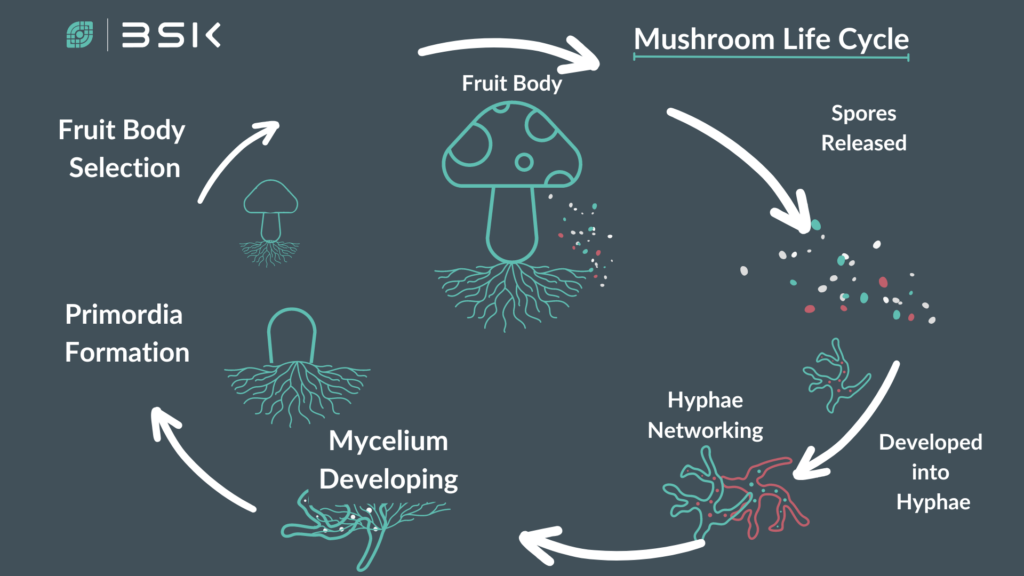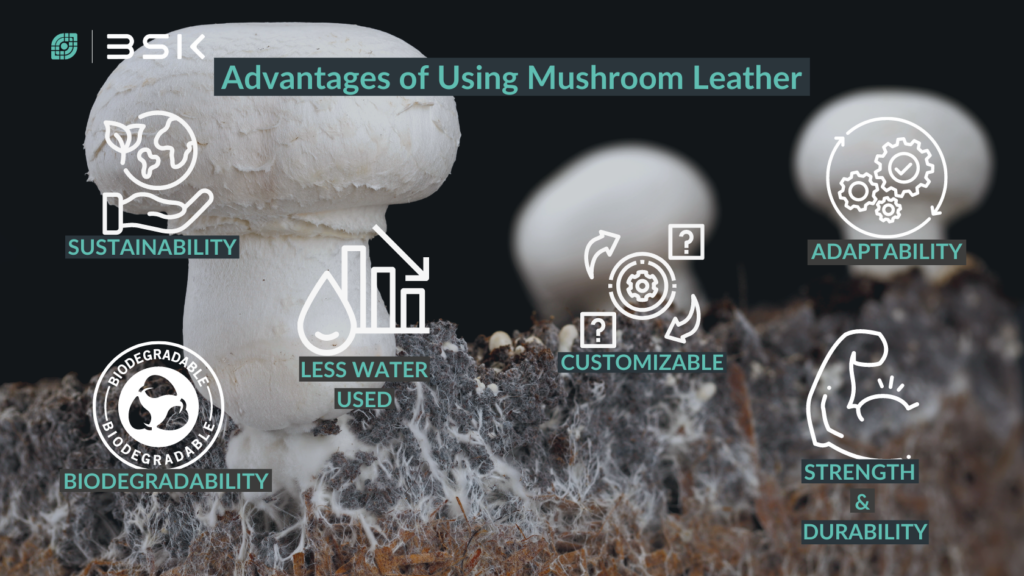Using mushroom leather in bag manufacturing might seem like a really strange idea to the average person. It did to me in the beginning, I won’t lie. However, as I delved deeper into the concept, I realized it was innovative and environmentally friendly. The development and production of bags affect durability and aesthetic appeal, and the materials typically used don’t align with sustainable practices. I’ve observed industry changes over the years and discovered that our environmental consciousness extends beyond customers. It stretches back to the designers and manufacturers.
In recent years, we have seen challenges for designers and manufacturers in adopting more eco-friendly practices. Sometimes synthetic leathers align with vegan-friendly consumers, but this may not align with climate-friendly practices. At this point, the acrobatics start; trying to please everyone might seem difficult and has proven to be for some. In recent years, we have seen the use of materials such as jute, hemp, ramie, and even straw resurge. This has been great as it promotes better practices and, in some cases, celebrates the heritage of using these materials. That’s why using mushroom leather in the bags is not just a new concept. It is also exciting to use what is around us consciously and healthily. Choosing mushrooms as a material reflects a commitment to reducing environmental impact without compromising quality or design.
What exactly is mushroom leather?
To be clear, mushroom leather in bags imitates leather manufactured from mycelium. Mycelium is a vegan-friendly alternative to cowhide and lamb leather. More importantly, it is an environmentally and animal-friendly material.

What is Mycelium?
Mycelium serves as an interconnected network of threads. Like structures, forming the basis of fungus colonies and the foundation for mushroom growth. This system grows by dismantling molecules in organic matter, like wood, and incorporating parts into its structure. Mycelium’s branched structure enhances its durability, making it a sustainable alternative to leather due to its inherent robustness. Mycelium is crucial to the mushroom’s lifecycle, serving as its root system, not separate but integral. Compared to a plant, the mycelium functions as the root, essential for the mushroom’s existence and growth.
Mushroom Leather, The New Plastic?
Using mushroom leather in a bag is a new concept, but it’s not exclusive to bags. Top car and sports brands‘ adoption of mushroom leather showcases its significant potential as a sustainable alternative. Whether for their car seats or shoes, mushroom leather has its place in the bag manufacturing industry. Manufacturers celebrated polyester and polypropylene during the WW II era, but now, the negative effects are becoming apparent. Nowadays, almost everything, from bags to packaging, contains plastic.
Additionally, mycelium, the material used to produce mushroom leather, is being developed for various applications, including furniture and construction, further illustrating its versatility and potential as a sustainable resource. Many now quickly consider mushroom leather as the new plastic. Or, evidently, picking up the slack for traditional leather.

The Advantages of Using Mushroom Leather
Exploring sustainable materials leads us to mushroom leather, an eco-friendly, durable, and customizable alternative to traditional leather.
Eco-Friendly Production: Mycelium cultivation requires minimal resources, such as water and energy, and can be grown on agricultural waste, promoting a circular economy. On the other hand, leather production uses a considerable volume of water. It involves a tanning process that traditionally relies on heavy metals such as chromium. These substances can harm the environment and human health, contaminating water bodies and soil. Moreover, relying on livestock for leather contributes to other environmental issues, including deforestation and greenhouse gas emissions.
Mushroom leather is a remarkably durable and versatile material. Its strength and flexibility make it perfect for various applications, from stylish fashion accessories to sturdy travel bags. Furthermore, it can be treated to enhance its durability, ensuring it can withstand everyday use demands.
In addition to its durability, mushroom leather offers a high level of customizability. The material can be grown and processed in such a way as to achieve a variety of textures, thicknesses, and finishes. This gives designers many creative possibilities, allowing them to craft unique and innovative products.
A significant advantage of mushroom leather, and arguably its most compelling selling point, is its rapid production timeline. In contrast to traditional leather, which requires six to eight weeks following the slaughter of an animal, mushroom leather presents a more efficient alternative. Depending on factors such as the mushroom species, the substrate used, and the specific growing conditions, mushroom leather can be ready in as little as two to three weeks, making it an outstandingly quick and environmentally friendly option in sustainable materials.
Limitations Of Using Mushroom Leather
While mushroom leather holds great promise, there are some limitations and challenges to consider:
The current production cost of mushroom leather is higher than traditional leather and synthetic materials. This cost differential poses a significant challenge to the widespread adoption of mushroom leather as an alternative material.
Scalability remains a concern for mushroom leather production because it is a relatively new material. While it shows promise, there is a need for further research and development to ensure that production can be scaled up to meet large industrial demands. This scalability requirement may limit the availability of mushroom leather as a widespread alternative to traditional leather products.
In challenging environments, such as extreme weather conditions, mushroom leather must demonstrate the same level of weather resistance and long-term durability as traditional leather to be a viable alternative. To overcome these limitations, continued research and development are essential, along with exploring complementary materials that can enhance the performance and reduce the cost of mushroom leather.
Mycelium Production and Manufacturing Considerations
From Spores to Style: The Craft of Mycelium Leather Bags
The production of mycelium leather bags involves a series of technical steps, starting with substrate preparation. This foundational step entails selecting and sterilizing agricultural by-products to create a growth platform for the mycelium. Following this, inoculation under controlled environmental conditions is crucial, with careful monitoring of temperature, humidity, and ventilation to optimize mycelium growth. The next incubation phase allows the mycelium to colonize the substrate thoroughly, forming a cohesive material network.
Once the mycelium-material blend fully colonizes the substrate, it is shaped within molds to achieve the desired bag dimensions and textures. This molding step is critical for shaping the product and determining its physical characteristics, such as density and strength.
The final phase involves smoothing surfaces and attaching functional elements like straps or closures as finishing touches. These steps aim to enhance the appearance and functionality of the mycelium leather bags, fulfilling specific design requirements and meeting consumer expectations.
Crafting Excellence: The Journey of Mycelium Leather Bags
Overall, the production process of mycelium leather bags requires precise control over a number of factors, from the choice of substrate to the conditions under which mycelium grows and the methods used to shape, refine, and finish the final product. Each step is crucial in defining the bags’ quality, appearance, and functionality, necessitating a careful and deliberate approach.
To better understand the intricate details of mycelium leather production, you might want to consider checking out this video by MycoWorks on YouTube. They have numerous resources visually demonstrating the production process, offering a deeper insight into the craft.
Sustainability and Environmental Impact of Mycelium
By cultivating mycelium, the vegetative part of a fungus consisting of a network of fine white filaments from various renewable agricultural waste products such as sawdust, straw, or other organic matter, we can effectively repurpose what would otherwise be waste. This method significantly reduces waste and promotes a circular economy that highlights sustainability and resourcefulness.
Low Environmental Impact: Cultivating mycelium for materials is an environmentally friendly process that consumes significantly less water and energy compared to the production of traditional leather or synthetic materials. Furthermore, the growth of mycelium does not require the use of pesticides or fertilizers, which helps to minimize its ecological footprint and makes it a sustainable alternative for material production.
Biodegradability: Mycelium-based products offer a sustainable alternative to synthetic materials. Unlike synthetic materials, which can take hundreds of years to decompose, mycelium-based products are fully biodegradable. They break down naturally, reducing long-term waste and environmental impact. Utilizing mycelium can significantly decrease our reliance on non-biodegradable materials, ultimately contributing to a healthier environment for future generations.
Conclusion
Using mycelium leather for bag manufacturing paves a new path toward sustainability in the fashion industry. We’ve traversed through the innovative realm of mushroom leather, from its unexpected entrance into bag manufacturing to its promising attributes in design and eco-friendliness. Mushroom leather, made from mycelium, offers durability, versatility, and customization, making it ideal for bag production. Its production is a stride towards a more sustainable practice. It requires minimal resources and solves the heavy environmental costs associated with traditional and synthetic leather production.
Embracing Innovation with Mushroom
However, while mushroom leather in bag production shines bright on the horizon of eco-friendly materials, it’s also important to be aware of its current limitations, such as higher production costs and challenges in scalability. These hurdles suggest that while mushroom leather is a formidable contender in the search for sustainable materials, there is a journey ahead towards making it a universal choice for manufacturers. Encouraging a shift towards mushroom leather requires consideration of its advantages and limitations. Designers, manufacturers, and consumers can align with environmental stewardship by using mushroom leather for sustainable products. Embracing this material could redefine your products’ aesthetics, utility, and environmental impact, setting a new standard for the bag manufacturing industry. Let’s consider the suitability of mushroom leather in our manufacturing needs, keeping in mind the balance between embracing new, sustainable materials and acknowledging the current challenges in their adoption.
